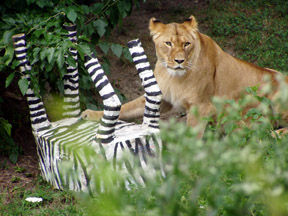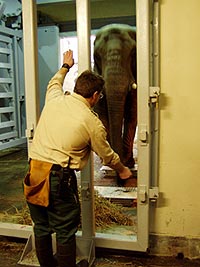Enrichment is the process of creating a challenging environment to address an animal's social, psychological and physical needs. Enrichment aims to enhance animal activity, provide mental stimulation and even improve the success of captive breeding of endangered species.

This lion toys with a "zebra" stuffed with some specially prepared ground meat, but it is much more than a game. The paper mâché piñata is a carefully crafted device used by zookeepers to provide a stimulating environment and elicit natural behaviors from the Zoo's wild residents. These special treats are part of an animal enrichment program designed to provide the best possible care for the Zoo's animals all year long. A committee of curators, animal keepers and veterinarians developed the program and continue to implement new ideas.
For Every Animal
Knowledge of an animal's natural behavior and physiology is important to an enrichment program. The program guides the care of each animal through consideration of many factors including exhibit space, location of rest and food areas, climbing structures, animal group size, and diet. Creative meals and treats - all approved by Zoo veterinarians - are a regular part of animal enrichment.
Thinking Big
Enrichment doesn't have to be edible. For example, huge brushes (like the kind used on city street sweepers) are hung high inside the elephant enclosures. In the wild, elephants use trees or termite mounds to scratch itches but the Zoo's elephants get the same effect sidling up to a brush.
 School's in Session
School's in Session
Three times each day, the zookeepers conduct elephant training sessions to bathe, examine and bond with Jo, Moshi and Martika. Training is definitely part of an enrichment program because the animals have to think, solve problems and communicate with their "herd," just as they would in the wild. Learning voice commands, special activities like painting (yes, our pachyderms are budding Picassos) and routine health care provide variety and challenges to each day, warding off boredom.
Sniff Sense
Many wild animals depend on an excellent sense of smell to sniff out prey, avoid predators or locate food and water. An olfactory workout isn't necessary for survival at the Zoo but zookeepers use scent to elicit natural behaviors from many species. Wolves, bears and tigers will investigate spices and squirts of perfume spritzed in their exhibits. Lions perk up to the scent of urine or dung from zebras and other "prey" animals. And the Zoo's rhinos will use their horns to bat cardboard tubes loaded with spices around their outdoor yard.
Move it
Even the minimally active two-toed sloth (why do you think they call them sloths?) exhibits exploratory behavior in the wild. Providing movable perching in the sloth exhibit will encourage exploration.
How Keepers Weigh Our Elephants
It was anybody's guess until recently. Since the Zoo didn't have a large 'walk-on' scale built into the floor of the Pachyderm Builiding, Zoo maintenance staff devised an alternative. The elephant scale is made up of four independent scales, wired to a single electronic read-out.
Mitch and Meghan, elephant keepers, prepare the scale as Jo watches through the doorway.
The scale is assembled in two parts. Jo will require training, balance and, of course, a reward to complete the task. See the fresh hay piled near the scale? |
![Preparation]() |
| Mitch opens the hydraulic door as Meghan invites Jo into the 'weight room.' Jo carefully inspects the scale with her trunk to make sure it's a familiar object. |
![Elephant Jo checks out the scale]()
|
| Jo's got it half right. Weeks of careful training pay off as Mitch works to reposition Jo. |
![Jo steps onto scale]() |
| Meghan uses a whistle to signal Jo that she's in the right spot on the small platforms. |
![Keeper signals stop via whisle]() |
| Success! Jo's feet are carefully placed on the scale and she holds still long enough to get an accurate weight - 8,500 pounds. The procedure was repeated on Moshi who weighs 8,321. |
![Jo weighs in]() |
| Martika had scale anxiety which many ladies can relate to, and was initially reluctant to hop on the scales. But she now climbs aboard and recently tipped the scales at 8,080 pounds. |
![Elephant feet]() |